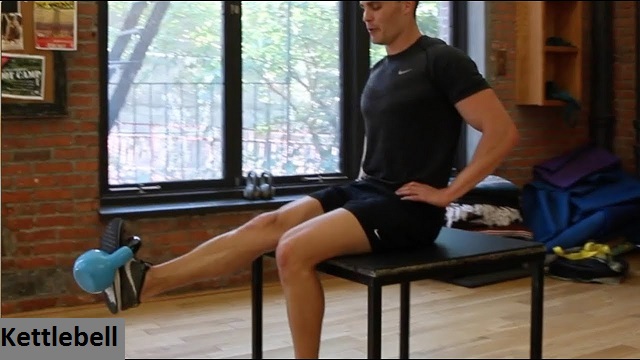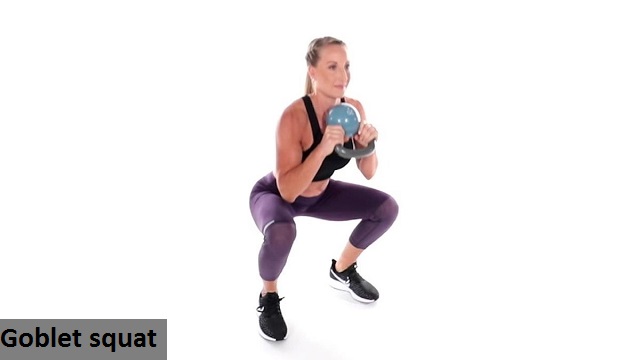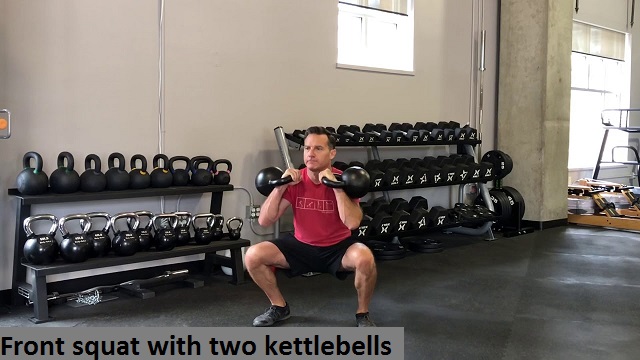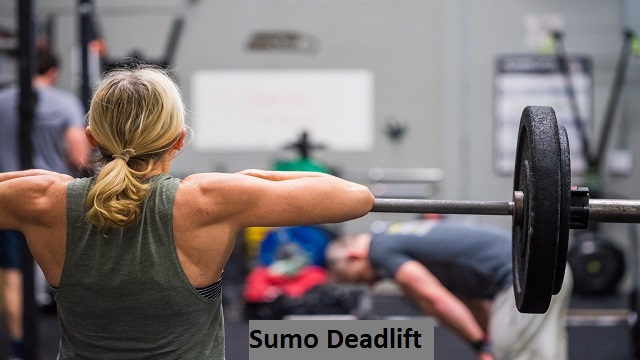
The best kettlebell leg exercises to strengthen your quads.
The most adaptable piece of exercise gear in the gym without a doubt is the KB. Kettlebells add more dynamic and functional movement to your leg day exercises, such as goblet squats, suitcase deadlifts, and more, in addition to the more traditional movements like the KB swing or Turkish get up.
In order to help you get strong as hell and develop your quads, glutes, and hammies, we’ll discuss some of the best kettlebell leg exercises.
Benefits Of Kettlebell Exercise:
In your functional strength training program, KB’s offer a number of advantages. When done for an extended period of time, traditional cardio training can put stress on your joints.
Kettlebells offer much lower-impact cardiovascular training. In a shorter amount of time, KB training also allows you to increase your endurance at a much faster rate.
Additionally, kettlebells offer exercise versatility by allowing you to vary your accessory strength movements and thereby increase your strength, power, and overall body strength. The majority of KB exercises are compound movements that call for the use of multiple muscle groups, joints, a stable core, and mobility to be performed properly.

Goblet squat with a kettlebell.
Every KB leg training day must include the goblet squat. The squat, a fundamental exercise that helps build strength and size in your legs, engages all the major muscle groups in your legs.
How to perform kettlebell goblet squats is as follows:
- Start by standing with your feet shoulder-width apart and pointing your toes in the direction of numbers 11 and 1 (as on a clock).
- With the handle pointed down by the ball, hold the KB with both hands in front of your chest.
- Once your knees are 90 degrees apart, push your hips back and stand back up.
Single-Arm-Overhead-Lunge mit Kettlebell.
Single-arm KB overhead lunges are an excellent functional leg exercise that help with core strength, mobility, balance, and of course, building bigger, stronger legs.
How to carry out single-arm overhead lunges with a kettlebell:
- Start by standing with your feet shoulder-width apart and pointing your toes in the direction of numbers 11 and 1 (as on a clock).
- You should extend your arm above your head while holding the KB in front rack position with your elbow locked out and tucked behind your ear.
- To maintain balance in your posture, your opposing arm should be parallel to the ground and at a 90-degree angle.
- Extend your opposite leg from your extended arm behind you into a lunge while keeping your arms locked in place.
- When you descend, your back knee will touch the floor as both knees bend simultaneously.
Bring yourself back to the starting position by driving through your front leg. - From there, step forward while extending your leg and performing a front lunge while bending both knees.
Replace your legs and arms after your set.

Front squat with two kettlebells.
The double KB front squat is a great exercise if you’re looking to increase your strength, strengthen your core, and boost your performance.
You are forced to concentrate on form and function because of the increased instability and constantly shifting load, which puts more strain on your abdominal muscles.
How to execute a double kettlebell front squat is as follows.
- Start in a standard squat position, with your feet shoulder-width apart and your toes pointing toward 11 and 1 (as on a clock).
- Using a moderate weight, clean both KB into front rack position.
- With your wrist in a neutral position, allow the KB to rest on your forearms, biceps, and shoulders.
- Instead of reclining into the classic back squat position, you’ll sit straight down, pressing your weight into your heels, engaging your abs, and maintaining a straight line with your hips.
- Breathe out as you push through your heels to the ceiling from the bottom position, bracing your core.
Congratulations! You’ve finished the first rep.
Deadlifting a kettlebell case.
Keep an eye out.The kettlebell suitcase deadlift is an easy exercise. However, you’ll quickly see how effective this movement is, especially the following day when the soreness begins. One of my favorite and most sought-after kettlebell leg exercises is the suitcase deadlift, which increases core strength and hamstring flexibility.
Steps for performing kettlebell suitcase deadlifts.
- Start standing with your feet slightly closer than shoulder width apart and pointed forward.
- Grab a kettlebell in each hand with the handle horizontal to your body and on the outside of your toes.
- Begin with two kettlebells on the ground.
- Your legs should be slightly bent at the knees, your chest should be parallel to the floor, and you should push your hips back towards the wall behind you.
- Pick up the KB while pushing your hips downward and flexing your glutes and hamstrings in this position.
- Extend your back toward the wall behind you.
- Pushing your hips back at the top will bring each kettlebell back to the starting position.
RDL with a kettlebell on one leg (Romanian Deadlift).
You’re going to adore this one if maintaining your balance is difficult. Your posture, balance, and patience will be tested by the KB single-leg RDL. Don’t worry if you struggle to complete this on your first or second attempt; the RDL requires practice. One of the best exercises for using a kettlebell on your legs because it works your glutes and improves core strength.
How to perform a single-leg RDL with a kettlebell:
- With the KB on the ground to start, hinge down and grab it with one hand.
- Push your leg from the same side behind you as your hips hinge down, holding the kettlebell at your side with your chest raised.
- Gently bend the knee on the other side, kick back while kicking your glutes, and then shift your weight to your heel.
- Keep your back flat and your leg straight while you’re stretched out.
- Drive your leg backward to the starting position as you come back, hunching your hips forward.

Swings with a kettlebell.
Kettlebell swings are a great full-body conditioning exercise that improves strength, power, and cardiovascular fitness. Swings specifically work the muscles in your posterior chain, which includes your hamstrings and glutes on the back of your body.
Kettlebell swings require space, so make sure no one will be in your way while you are performing them.
- Place your feet about shoulder-width apart while standing.
- Put a kettlebell on the ground in front of your feet. Keep your core tight and your shoulder blades pulled back and down as if you’re expecting a punch while bending your knees just a little bit.
- Holding your KB requires you to hinge your hips back and your torso forward simultaneously.
- Keep your back straight and bend your knees just slightly (do not squat).
- To grab the KB, inhale. To forcefully rise to your feet and stand, exhale, tighten your glutes and hamstrings, and thrust your hips forward.
- The KB will naturally swing up to about shoulder height. Your arms should only be used as a hook, not to lift the object.
- Once more bringing your hips back, exhale as you let the fall back between your legs.
- Your torso should move in unison with your hips as you maintain a straight spine.
Turkish Split Squat.
A great unilateral exercise that targets the glutes, quadriceps, hamstrings, and calves is the bulgarian split squat. They can help strengthen muscles unevenly distributed and develop stability and coordination.
- Hold a pair of kettlebells—one in each hand—or hold one in the goblet position in front of you at chest level as you stand in front of a bench while facing away from it.
- Maintain a tight core and retracted (back and down) shoulder blades.
- In order to keep your balance, lift your right foot and set it on the bench behind you. Using your front standing leg, perform the task.
- Brace your core and squat on your left leg while bending your left knee.
- Your right knee will drop toward the floor as your torso leans slightly forward.
- Put equal weight on your front foot.
- When your front leg is parallel to the ground, or even lower, lower yourself.
- To get back to standing, squeeze your glutes and push through your front foot.
- Before switching sides to repeat, finish the desired number of repetitions on one side.
Squat with a rack.
The racked squat is a power and strength-enhancing exercise that specifically targets your glutes, hip flexors, and quadriceps. As you attempt to balance your weight in the front-racked position, your core will begin to light up.
The racked kettlebell squat can be executed using either one kettlebell or two, one in each hand. If you’re only using one kettlebell, hold your free hand out to the side (see illustration above) to act as a counterbalance.
- Put a kettlebell in each hand and hold them in the “racked” position, with the bell in front of the shoulders and the wrists in a neutral position.
- Depending on your mobility, brace your core, swing your hips back, and bend your knees to squat parallel or lower.
- To get back to the starting position, drive your weight into your feet and lift your hips with your glutes and quadriceps
- can be used to perform the back squat; however, you must use less weight than you would for a back squat with a bar. Squats exercise your entire lower body, and the version may cause your core to work harder as you attempt to stabilize the weights.
- Put your feet about hip-width apart when you’re standing.
- With your palms facing forward and elbows pointing down, hold one with this on the back of each shoulder.
- To lower into a squat, swing your hips back and bend your knees.
- Maintain an upright posture with your chest up and a neutral spine.
- Once your thighs are at least parallel to the floor, keep lowering yourself.
- To get back to standing, squeeze your glutes and push your hips forward.
The sumo squat.
A squat variation known as the sumo squat is ideal for use with kettlebells as they aid in maintaining weight balance, enabling proper form, and emphasizing the right muscles, namely the glutes and quads.
The sumo squat, as the name suggests, alters the standard slightly wider-than-hip-width stance to one that is noticeably wider, resembling a sumo wrestler.
- The picture above shows two ways to hold a kettlebell: cupped hands at chest height or hanging between your legs.
- Your toes should be pointing out at roughly a 45-degree angle as you stand with your feet 8 to 12 inches wider than hip-width apart. At this angle, with your thigh bones aligned with your feet, you should also stand.
- Take a deep breath in, hinge your hips back, bend your knees, and lower yourself into a squat position. Ensure that your spine is neutral and that your core is tight.
- Your knees should follow the direction of your side-facing toes.
- With an exhale, push through your feet to return to the starting position while activating your glutes and reversing the motion.

Sumo Deadlift:
The sumo deadlift, a popular compound lift variation based on the sumo stance, also works well with a kettlebell. Sumo deadlifts put less strain on the lower back, making them a great option for beginners or anyone who has lower back tightness.
Your quadriceps, back, hamstrings, calf muscles, hamstring adductors, and hamstrings will all be worked out by sumo deadlifts. As opposed to the traditional deadlift, this exercise will focus more on your glutes, adductors, and hamstrings.
- Standing with your feet slightly wider than shoulder width apart and slightly turned outward.
- Your hips should be underneath the kettlebell.
- Breathe in, tighten your abdominal muscles, and start bending your knees so that they are parallel to your shins.
- Your spine should remain neutral as you bring your hips back, keeping your chest up.
Take an overhand grip on the kettlebell with both hands. - Pull up to contract your lat muscles and legs, locking your shoulder blades down and back.
- As you raise yourself upward, start to push through your feet and push your legs into the floor.
- As you lift the kettlebell, your arms ought to be close to your body.
- Flex your hips to their fullest extent while tightening your glutes.
- With the kettlebell between your legs, exhale as you reach the top.
- Keeping an engaged core and a neutral spine, slowly lower your back down. To get back to your starting position, reverse the motion.
Read More: Tricep exercises for men
Leave a Reply